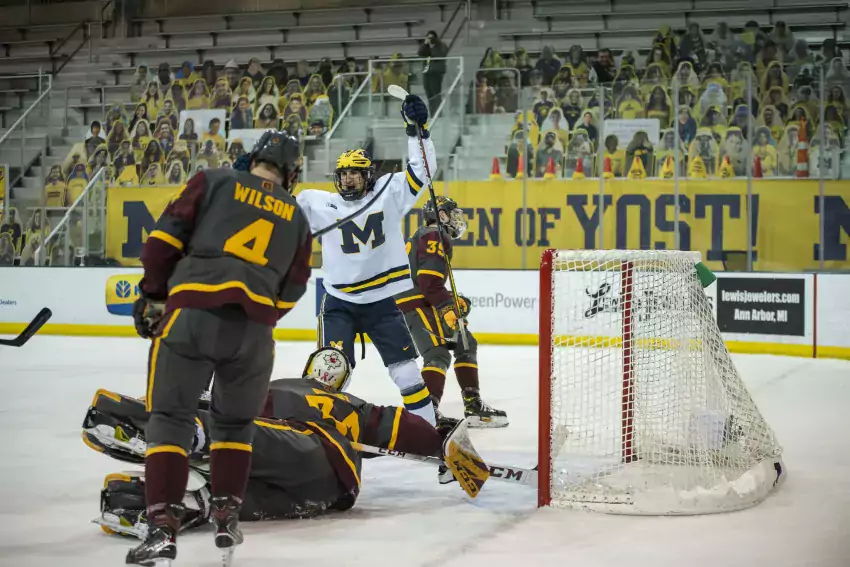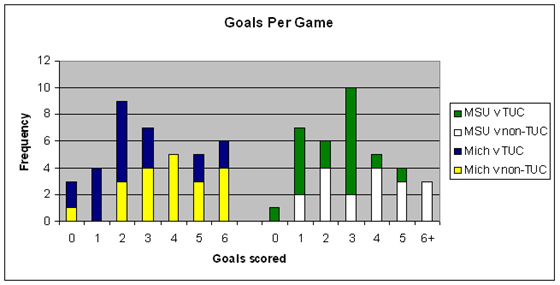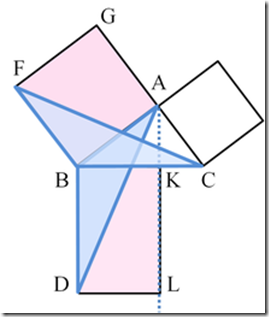pythagoras

Bill Parcells is famous for saying "you are what your record says you are," which is a good thing for a coach to say. Coaches are in the motivation and dedication business. They are not in the "being accurate in press conferences" business, though, and a lot of people interested in how to project past performance into the future think Bill Parcells is wrong.
I do, too, which I why I've been saying Michigan hockey was snakebit instead of trying to draw up plausible mechanisms why they'd spend slightly more than half their time napalming opponents and slightly less than half their time losing to them in improbable fashion. This post is an attempt to justify that assertion.
[After THE JUMP: graphs! charts!]
I like me some stats, boy howdy, but there's a few things I'm not sure about. One is applying Pythagorean wins to football. For those of you who don't know the name of Data's brother, some smart baseball types realized that baseball teams pretty much try to score runs all the time. This means you can predict future performance better with run differential than record.
It works in basketball, too, because basketball teams pretty much try to score baskets all the time. A team leading may try to suck a possession or two out of the game by stalling late, but that effect is extremely minor. It works in hockey because hockey teams pretty much try to score goals all the time. A team leading late will take fewer risks but that effect is minor, too. Futz with the exponents and it's cool.
You can do this for football as well, but Lloyd/Tresselball observers can tell you that football teams do not try to score points all the time. This is because football has more state—primarily the line of scrimmage—than the other sports, and that state is simultaneously applicable to offense and defense. There is never any reason to not score in baseball or basketball. In football trying to score is riskier than running three isos up the middle and punting in a way that missing a jumper is not. Because of this, lots of personnel turnover, and wildly varying schedules, I don't think raw Pythagorean wins is a particularly useful predictive device. It does correlate some. I just don't like it. I acknowledge this is a Murray Chass sort of criticism.
I bring it up because BHGP has a long post featuring Pythagorean wins that eventually kind of discards the concept by way of praising Northwestern for consistently exceeding expectations. There's a table I'll post a bit later showing eight years of Big Ten performance versus expectations followed up by this:
The fact that most teams have such consistent "luck," when coupled with the fact that close wins and losses appear to be the strongest factor in where a team appears on the list, means this list may not be a measure of "luck," per se, but rather the simple ability to win close games. Since such ability is presumably based in large part on things like on-field experience, efficient playcalling, and clock management, the list could be considered a measure of a coach's in-game ability. Is it any wonder that the conference's biggest late-game buffoon and a geriatric who doesn't even wear a headset sit at the bottom of the list? …
It's also a credit to Pat Fitzgerald and the late Randy Walker at Northwestern. Even in its worst years, jNWU has outperformed its pythagorean expectations. In every year included in this study, Northwestern had a positive overall pythagorean margin, and in all but one the LOLcats had a positive margin in conference play.
There is an objection to this based on stock-picking monkeys.
Seriously. In 1999, a six-year-old female monkey named Raven threw darts at a selection of tech stocks that subsequently returned 213 percent. This was a bubble environment but even in that context her performance was impressive—22nd amongst thousands of funds. If you had 64 monkeys do that every year half of them would be discovered to be frauds by not beating the market, but you would expect at the end of that eight year period there would be one very lucky monkey who beat the market for eight consecutive years.
Any normally distributed set of data is going to have a lucky monkey and Ron Zook. I present a lucky monkey and Ron Zook:
Wins – Pythagorean expectation, 2002-2010
| Rank | Team | Ov +/- | Conf +/- |
| 1 | Northwestern | 9.74 | 8.28 |
| 2 | Wisconsin | 3.18 | 0.34 |
| 3 | Indiana | 2.00 | -2.16 |
| 4 | Ohio State | 1.90 | 1.21 |
| 5 | Michigan | -0.55 | 2.15 |
| 6 | Michigan State | -3.38 | -0.45 |
| 7 | Iowa | -4.37 | -1.21 |
| 8 | Minnesota | -4.65 | -2.46 |
| 9 | Purdue | -7.14 | -3.30 |
| 10 | Penn State | -8.70 | -4.91 |
| 11 | Illinois | -9.31 | -5.75 |
Except… that is not a normally distributed lucky monkey. In conference (which is a more interesting number to me because nonconference schedules are so unbalanced), Northwestern accounts for nearly 70% of the deviation from perfectly Pythagorean records by itself. Lloydball advocates Michigan, OSU, and Wisconsin follow in order, and BHGP points out that Michigan State would be the second luckiest monkey if only the Dantonio era—more MANBALL—was considered. There seems to be something non-monkey there.
But I'm uncertain if that's good or bad if you're a fan. Does this mean manball is good at closing out games, as BHGP suggests the chart shows? It's a possibility. The other possibility (24-21 vs SDSU, 10-7 vs Utah, falling behind by 14 in the Orange Bowl before suddenly remembering David Terrell exists, etc.) is that Lloydball-type play shuts off the offense once it gets a narrow lead or until it falls behind significantly, thus leading to a lot of tight games generally slanted towards wins.
The most haunting stat from the Carr era is this: Carr was actually more likely to win a game if he entered the fourth quarter with a narrow deficit than a narrow lead. Since the point of football is to win more games, period, not more games than you were expected to based on the final score, the excellence of your coaching is bound up with your record. Exceeding expectations as Ohio State means your manball is working (until you get into a championship game). Doing so as Michigan, but never beating Ohio State, means something different.
There's too much weird stuff tied up in scoring points in football to draw many conclusions from a look at just margins. Primarily this comes down to wanting to score, which is a complicated decision based largely on your faith in the defense. This is hard when your defense is good-ish (Michigan) but not when it's terrible (Northwestern) or awesome (Ohio State). OSU and Northwestern rarely make the wrong decisions because theirs are obvious. Michigan (and Iowa, and Penn State) fans are haunted by the the decisions that turned out wrong.
BONUS GUESS ON NORTHWESTERN: Why would the Wildcats consistently exceed expectations? Guess: they feature in games with lots of points. Their spread has been as consistently effective as their secondary has been flailing, so a lot of Northwestern games feature large scores. If NW is consistently winning 42-35 that will look different to the formula than OSU grinding out 17-10 wins.
BONUS LOCALLY RELEVANT SECTION: FWIW, only one Michigan team shows up at the margins. If you think about it you'll probably figure it out:
Of course, using the full schedule allows for statistical variance based on strength of non-conference scheduling. If we look solely at Big Ten play, as close to a level playing field as we can get, Sparty still wins. It's just not 2010 Sparty:
Rank Team Py +/- 1 2008 Michigan State +2.16 2 2004 Northwestern +1.77 3 2010 Michigan State +1.69 4 2004 Michigan +1.63 5 2009 Northwestern +1.53 That 2008 Spartan squad went 9-4 (6-2) despite a total margin of victory of +28 and an in-conference margin of -7. In fact, 2008 Michigan State was one of just five teams since 2002 to post a winning record in the Big Ten despite being outscored in conference play.
The 2004 team that went to the Rose Bowl despite deploying a freshman quarterback thanks to things like nailcoeds.exe outperformed Pythagorean expectation significantly. You might be all like "a HA!" because the next year Michigan slumped to 7-5 in 2005, but they went 11-2 the year after that—there's just so much noise.
| WHAT | Michigan @ Michigan State CCHA Second Round |
|---|---|
| WHERE | East Lansing, Michigan |
| WHEN | 7:05PM EST March 12th/13th, 2010 If necessary: 7:05 PM EST March 14th |
| THE LINE | College hockey lines, junkie? |
| TELEVISION | Friday & Saturday: Comcast Local |
Michigan State
Record. I'm pretty sure that frequent commenter Spartan Dan put together a killer weekend preview at The Only Colors simply to shame me—it's even got this site's usual "you want this WCHA series to go this way because of the marginal effect it will have on our pairwise comparisons" section—and shame me it has done. It has also done a significant amount of the legwork, though, so we'll call it even.
Anyway: 19-11-6, 14-8-6 CCHA. Second place. Goal differential of +0.67 per game overall and +0.32 in conference. Bizarrely, Michigan's goal differential is considerably better in both instances (+0.85 and +0.5, respectively) despite being the seventh seed here. What's going on? Dan has a great chart that helps explain things:
 Right away you can see more spread in Michigan's goal results. State scores three a lot, zero almost never, and six relatively rarely. Their goal curve somewhat approximates a normal distribution. Michigan has nights of wild success and nights like… well, you could name a dozen at this point. This dovetails nicely with a post I threw on mgolicious recently about a new method for reducing the error in baseball's Pythagoran prediction schemes*. It's kind of obvious:
Right away you can see more spread in Michigan's goal results. State scores three a lot, zero almost never, and six relatively rarely. Their goal curve somewhat approximates a normal distribution. Michigan has nights of wild success and nights like… well, you could name a dozen at this point. This dovetails nicely with a post I threw on mgolicious recently about a new method for reducing the error in baseball's Pythagoran prediction schemes*. It's kind of obvious:
Your actual win total doesn't just depend on runs scored and allowed -- it also depends on the consistency of each. If your scoring is less consistent than average, you should outperform [ed: I don't think this is good phrasing.] Pythagoras in terms of wins. For instance, if you score exactly the same number of runs as you allow, you should wind up a .500 team. But if you win more blowouts than average -- by scores of 15-2 and 16-6, for instance -- you'll finish at less than .500, because you've "wasted" your runs when you don't need them. And if you *lose* more blowouts than average, you'll win *more* games than 50 percent, because your opponents are "wasting" their runs.
A team that scores zero goals half the time and eight goals the rest of the time is going have the best goal differential in the world and be .500.
it's a little tough to parse this pattern out, but try to just consider the TUC games (blue and green). There the pattern is even more stark: State still scores three a ton, with one the next most popular and some other scattered numbers. Michigan's mode is two—ick—and the goal scoring is much more distributed. TUC teams are the top half of the schedule and more likely to score goals against you: here is the gap between Michigan's goal differential and its record.
Is this luck or something wrong with the team? Dan makes a case for the latter based on Michigan's style of offense this year ("chuck it at the net and see what happens") and I agree with him. The posterboy for this effect is Louie Caporusso, who has been on a tear of late against iffy goaltending and poor defensive teams but was totally stymied against the meat of the schedule. Michigan as a whole seems like TJ Hensick trying to make it in pro hockey: too good for the AHL (usually) but not good enough for the show.
This is a long and complicated way of saying that I wouldn't put as much into the goal differential as you might otherwise. I think it bodes well for Michigan next year, but maybe not this weekend.
*(For those less likely to have a collection of German board games: Bill James took a look at the numbers and found out that run differential was a better predictor of next year's record than last year's record. This finding is generally applicable and definitely applies to hockey. It's a major reason I think the hockey team will bounce back to its usual terrifying self next year. There's no place like home… no place like home… no place…)
Dangermen. Insert default complaint about Corey Tropp… no, insert a new one: it is totally ridiculous that the only punishment Corey Tropp received was missing the remainder of a season in which State had already checked out for good anyway. Michigan State had such deep respect for the idea that Corey Tropp should sit out games that they tried to stash him in the USHL so he wouldn't get rusty and only backed off that plan when someone in compliance said it would affect his eligibility. Rick Comley has permanently lost my respect, and the way this incident has played out makes me long for the day when Michigan can tell the league to GTFO and join a Big Ten hockey conference.
But anyway. Karma is busy with the Spartan football team at the moment and has ignored the above, so Tropp is Michigan State's leading scorer with a 20-22-42 line. Derek Grant has 11-18-31 and Andrew Rowe a 15-11-26, from there there's a significant dropoff. Expect Hagelin to get the Tropp line whenever they can manage it.
Defense and goalie and whatnot. Drew Palmisano has developed into one of the country's best goalies—something you could see coming as he split time with Jeff Lerg last year—and has a .922 save percentage.
Earlier in the year I suggested that Michigan State's extremely young defensive corps might be an exploitable achilles heel, but I just looked at the year next to their name and not their birthdates. None of these guys is straight out of high school and some of them can already drink. (Drink legally, that is. These are hockey players.) "Freshman" Zach Josepher is a few months away from turning 22! So nevermind on that.
The key guy on the Spartan D is Jeff Petry, a second-round pick of the Oilers who had a terrible year last year beyond just having crappy teammates but has bounced back to be both the Spartans' best offensive defenseman—22 assists—and most reliable defender. Josepher and fellow freshman-type object Torey Krug (actually younger than 20) are the next two guys on the depth chart. Krug is a smallish puck mover, Josepher more of a defensive sort.
Michigan, meanwhile, is still rolling out pint-sized walk-on Shawn Hunwick. This is good for the profile-seeking newspaper writers of Southeastern Michigan, but maybe not so good for Michigan's chances this weekend. Both of the goals Lake State scored on Friday were super soft and I'm sure everyone else is as creeped out by how often he jumps at pucks as I am. On the other hand, the two Friday goals were the only on the weekend and Hunwick did make a couple of grade A stops on Saturday to preserve his shutout.
While it's not a foregone conclusion that Hunwick is outperformed, it's pretty likely.
As a bonus, senior captain Chris Summers is out. Lee Moffie draws into the lineup, and this might mean bad things defensively. It just goes to show that I don't know everything (or even much) about hockey that I thought he was killing it when this was going down:
But after he dressed in 13 consecutive games, Moffie was pulled for his defensive lapses. In the final five games of that stretch in late January, Moffie had a plus/minus rating of minus-five. He has played in just four of the last ten games.
“I’ve known from the start that the defense is my thing that will keep me out of the lineup, they made that pretty clear,” Moffie said. “I’m an offensive defenseman, if I’m not producing and I’m out there for goals, I’m not really worth a lot to this team.”
His defensive issues must be a lot more subtle than Llewellyn's tendency to pick up dumb penalties and get caught up ice.
Special teams. Your power plays per game stat:
| MSU | Michigan | |
|---|---|---|
| PP For / G | 5.6 | 5.7 |
| PP Ag / G | 5.1 | 5.4 |
Michigan's specialty units are more effective than State's. Michigan's penalty kill is borking along at a 87.6 rate. Michigan State is in the middle of the pack (20th) at 83.2. On the flip side, neither team is much good on the powerplay. Michigan is 29th, State 34th. That's basically a wash.
Since Michigan State has a better ratio of PPs for and against, this section is basically even.
Michigan Vs Those Guys
Play like an underdog. Michigan's been playing a tighter, simpler game with Hunwick in net and the results have been fewer scary turnovers and few grade A opportunities. Michigan State is a step up from Hunwick's first four games, which were against 9th place Notre Dame and 10th place Lake State and will actually be able to generate scoring chances of their own. Michigan should play a conservative game in the hopes of protecting Hunwick.
Clone Carl Hagelin and put him on three lines.
Figure out why you are so inconsistent, especially against TUC opponents, and fix that season-long issue in a week. What? It could happen.
The Big Picture
The Pairwise still doesn't matter for Michigan. They're 25th right now: it's CCHA championship or bust. That requires winning this weekend and against Miami unless Ohio State pulls off the upset of the year in the CCHA, with Ferris State or Alaska or someone else the last hurdle. The pulse still remains faint.
On the other hand, the Pairwise implications of this series are huge for Michigan State. They sit 12th. With Bemidji State comfortably in the top eight, there is only one auto-bid that is definitely getting handed out. You could get in with a PWR as low as 15, but to be safe you'd like to get to 14 or, better, 13. If Michigan State loses this series they will take two TUC losses against zero or one wins. Depending on the results of other series, this could knock them out of the tournament entirely.
Michigan's playing for its life in this series and doesn't need anything else to motivate, but that's a nice little bonus.



24